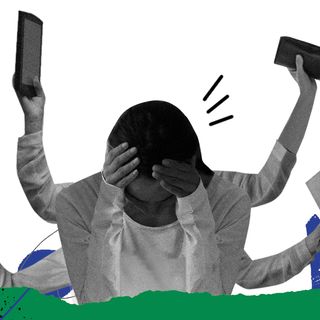
What Do We Lose When We Don’t Inhabit Physical Spaces Like Offices, Universities?
Built environments give us tangible memories, better interpersonal relationships, and meaning to our academic or professional pursuits.

Saika talks about her “spot” on the college campus with a hint of nostalgic fascination. Think arched windows framing the view of a sprawling garden. A wide ledge that becomes a placeholder — for unfinished assignments and coffee — or even a stiff chair for people to sit or lean on for comfort.
There is nothing unique about her spot, the 22-year-old clarifies, but “almost every time someone mentions college, I can’t help but wonder how much of it would have changed.” Or how much that one red-brick building, the energy wrapped in its beams and pillars, changed her.
For Eshika, 23, this change is palpable, but hard to articulate. She switched jobs during the pandemic, and the transition came with shifting the workspace from a bullpen and office chatter to the confines of her room. But she carries a memory of the glass building, and all that it brought: “The loss of the water cooler banter, the in-person brainstorming sessions, eating lunch with teammates, going for a walk around the office campus to come out of that post-lunch slump…”
A constructed environment, like that of universities or offices, comes with certain promises. There is wellness and health, the spirit of innovation and collaboration, a boundary between the personal and professional, and an unrivaled sanctity. There is a reason we call it “work life” and “college life” — these environments became the backdrop to our life at that moment in time.
Not getting to inhabit these spaces, then, changes how we engage with and perceive our work and personal lives. This becomes pertinent at a time when people are joining their first jobs from home, or graduating college without ever visiting this entity attached to experience; they lose out on tangible memories and better interpersonal relationships.
“We’ve all collectively mourned a lot of things over the past 15-something months,” Eshika says. The loss of physical spaces was one of them.
***
Physical spaces have a heartbeat of their own. Consider how memory is formed in our brain: the first step, called encoding, happens when the brain perceives sounds, images, and physical feeling. It becomes something for our memories to latch onto. The people — they come later, and contribute to a feeling that furthers our association with the place.
Research confirms this: in environmental psychology, “place attachment” refers to an emotional bond between a person and a place; when people associate meaning with places. Our interaction with the built environment happens on three levels: cognitive (we understand the form and spatial structure), behavioral (space provides a function, such as an area to work or study or eat), and emotional (where we derive satisfaction and establish an attachment to the place).
The emotional connection is the strongest; Yi-Fu Tuan, a researcher of humanistic geography, coined the term “topophilia” to describe the love people may feel for particular places.
Moreover, research has shown that when we attach meaning to this physical setting, we tend to remember and retain things better. This perhaps explains the shapelessness of time and memory during the pandemic — all experience feels like one experience. “All of that [college life] is lost… Now it’s more like a distant memory I would not be able to trace my way back to,” Saika notes.
And like the physical space becomes the “first” association of experiences, it equally influences endings. For graduates this year, the absence of closure was particularly gnawing. “This is not how you move through transitions, you need time and a tangible space to make sense of these changes,” Sneha, 22, says.
Related on The Swaddle:
Work, Re‑cultured: A Start‑Up Employee Finds an Already‑Bad Work Culture Got Worse
Ria Chopra made a similar transition. The 22-year-old joined her first job in the work-from-home setup. Talking about what she missed out on because of this, she believes “the physical space definitely influences some intangible feelings we have about the institution itself.”
For her, not being able to interact with her colleagues in a physical space has led to the loss of “a sense of belonging, of being part of a shared space with other people and having the shared identity of belonging to that same space, the cultural elements which can only be experienced physically.”
Robin Dunbar, professor of psychology at the University of Oxford, noted in the BBC that the workplace is “a social environment, and business in any form is a social phenomenon.” The same idea can be applied to schools, universities, or any shared place that becomes a source of meaning.
This is a concept validated in social theory. Author Robert Putnam popularized the concept of “social capital” in his book Bowling Alone. The hypothesis was such: In a job setting, social capital is accumulated by working in the presence of others and depleted during virtual interactions.
One of the reasons for this is these spaces house spontaneous social interactions: the layout in itself constructs a geography of conversation and interaction. People speak of a place’s “energy,” as if it were a living being.
“The lack of spontaneity in boxed screens makes work very transactional, making it harder to engage with other people,” Sneha notes. This engagement is not to be trivialized — it is the basis of friendships, signifies what experts define “interpersonal relationships,” becomes a source of motivation for many people, and offers ownership of one’s work or career.
“In online workspaces, you’re just this voice in the phone, right? You’re just this email, they don’t know who you are. And honestly, they don’t have the time to care. So they will treat you however they want. If you don’t do anything, they’re not interested in teaching you. Because there’s no time for that,” Sneha notes. Friendship, camaraderie, and mentorship all take a hit.
“I’m spending hours each day working with people I haven’t ever met, and as all interactions are intentional and work-related, one has to really make an effort to get to know people,” Ria notes.
In the end, a sense of belongingness, Sneha says, is left wanting.
Sneha had a spot of her own too in college, which came with its ritual and where people often collided — a coffee kiosk that they would visit the minute they stepped out from classrooms, with students from all batches flanked on either side.
“I think physical spaces were very important for us because that is what we associated with our college experience. It’s not necessarily the classroom. Like, okay, education has changed, learning modes have changed, and that you can probably still get on board with. But how can you replace these stolen moments of bonding?”
Related on The Swaddle:
‘Toxic’ Workplace Culture Linked To a Threefold Increase in Risk of Depression, Study Shows
A global survey conducted this year showed a number of “pain points” for employees, most of which can be traced back to a lack of physical spaces: lack of spontaneity, difficulty in integrating new hires into company culture remotely, Zoom fatigue.
Besides framing social relationships, the physical space is also linked to creativity and motivation. This is evident by how office designs have evolved in the past few years: hierarchical walls and cubicles have blended into open-seating, team-based layouts.
Manager and human resource professionals also consciously try to create collisions among employees within workplaces — studies show that these chance encounters and unplanned interactions improve performance. “The creativity that comes from spontaneous collaboration; the trust and relationships that are built through countless and unsaid small gestures and interactions,” Vaibhav Gujral, a partner at McKinsey & Company, noted in BBC.
In contrast, the home office is stripped of this social element. The “loneliness pandemic,” as the phrasing has emerged over the last year, is associated with a culture of being boxed in our rooms and screens, cramped, bored, and lonely.
More viscerally, the space becomes a symbol of demarcation in separating the personal from the professional. In a way, it preserved one’s mental and emotional health. “If you take that [the social element] out of the entire education/work situation, you can’t keep going, you will get tired, you will get burnt out. And which is what’s happening,” Sneha says.
***
Arguably, our homes have evolved to respond to our needs. It offers a comfort of its own — sometimes more preferable for people who faced acute harassment in the office, struggled with equitable treatment, or were neurodivergent.
But acknowledging what is impacted will help answer how, and if, we can bring the emotional value of the physical space, minus the inequities and status quo, closer to us.
In a physical space, it’s much easier to visualize how each person’s work connects to other work, and how things contribute to building the ‘big picture.’ Behind the scenes, or away from the scenes, the atomized manner of working gives precedence to the disconnect we feel over the work.
In the end, we are shaped by the emotional and actual geography of a place.
At the start of the pandemic, researchers mulled over the existential question of the ideological construct of an office: Is it a place to learn from experienced colleagues, a platform to innovate, a provider of social life and levity, a reason to leave the house? The answer, then, is all of these.
Perhaps, talking more about this lost association will help revive that lost connection. Workspaces are increasingly trying to fill the gap by hosting game nights or more spontaneous interactions — in an attempt to simulate the physical space.
Think of physical spaces as tangible, visual symbols that represent meaning for our activities in life.
It is as Joan Didion writes in Let Me Tell You What I Mean, describing San Simeon, a place with moorish towers, as follows: “a material fact which existed in proof of certain abstract principles.” The footsteps, indistinct buzz, a rhythm of activity all form a meditation on our identity. Built environments allow us to exist tangibly in this world — and not just in our heads.
“I think more than just academics or work,” Sneha says wistfully, “this is what people miss — just hanging out in these areas, giving an association to our memories, and even ourselves.”
Saumya Kalia is an Associate Editor at The Swaddle. Her journalism and writing explore issues of social justice, digital sub-cultures, media ecosystem, literature, and memory as they cut across socio-cultural periods. You can reach her at @Saumya_Kalia.
Related


Woe Is Me! “My Boyfriend Lied About Seeing His Ex. Should I Forgive Him?”
